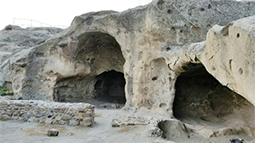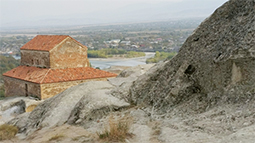Story and Photos By Eric Freedman

Narikala Fortress
Georgia is an ancient mountainous country settled thousands of years ago. Some of the most dramatic evidence of its past are what’s left of the fortresses, castles and stone walls build to protect the country from invading armies of Romans, Russians, Persians, Arabs, Turks and other peoples seeking to conquer Georgia – and who often succeeded.

Remains Narikala Fortress
Above the Old Town section of Tbilisi you can visit the remains of Narikala Fortress. The original fort overlooking the Kura River was built about 1,700 years ago, restored in the 1500s and ruined in an 1827 earthquake. Much of the fortress has crumbled, but some walls still stand. The fortress is illuminated at night and glows with yellowish-brown colors – I can see it from my 8th-floor apartment window a few miles away.
The picture above shows part of the remains of Narikala Fortress as seen from the National Botanic Garden of Georgia.

Watchtower Ananuri
Ananuri was once a castle and seat of the feudal dukes of Aragvi. Their watchtower and church complex stands tall partly intact, partly in ruins. What was it like to be on guard duty in places like these isolated outposts, lonely outposts, on bitterly cold nights with the security of a kingdom riding on your ability to spot and defeat relentless enemies?

Ananuri castle
It’s not only forts that stand high for protection in Georgia. So do Orthodox churches and monasteries that provided physical as well as spiritual protection. One is the 6th-7th century Jvari Church looming above the country’s one-time capital of Mtskheta.

Gergeti Trinity Church
It was on this site that, we are taught, Saint Nino – who is credited with converting Georgia to Christianity – erected a cross overlooking shrines to the pagan gods.
Similarly, the 14th century Gergeti Trinity Church looks tiny from the town of Stepanstminda far below, while Stepanstminda and the Georgian Military Highway heading north to Russia look tiny from the church grounds far above.

Sentry spot Gergeti Trinity Church
Worshippers lit candles during my visit but it’s easy to envision sentries on duty here amidst snow-capped mountains and fierce winter winds.
Even older are the ancient remains of the cave city of Uplistsikhe, about an hour’s drive from Tbilisi. Here you can wander through centuries-old ruins. Life must have been harsh here – no running water, no bathrooms, no internet, no fast food, no malls.

Looking down on the town from Gergeti Trinity Church
This site once hosted temples dedicated to the sun goddess and served as a trading center for merchants and caravans traveling along the Silk Road that connected Europe with Central Asia and China. The paths are steep and sometimes slippery, but at the top are scenic views of the valley below.

Caves of Uplistskihe
And the view from there:

View from caves
